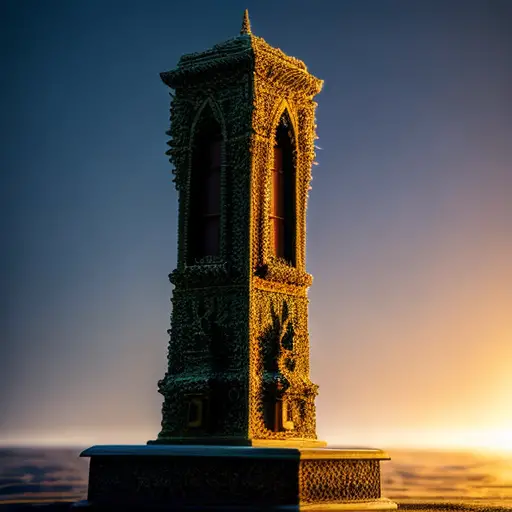Welcome, fellow art enthusiasts, to a whimsical journey through the captivating realm of freestanding sculptures! Picture this: a sculpture that stands tall and proud, defying gravity with its three-dimensional charm. These masterpieces, unlike their wall-hugging counterparts, possess an audacious independence that demands attention. With no need for pesky pedestals or walls to lean on, freestanding sculptures boldly occupy their space, inviting us to marvel at their intricate details from every angle. From the majestic marble figures of ancient Greece to the mind-bending contemporary creations, these sculptures embody the essence of artistic freedom, quite literally standing on their own two feet. So, buckle up and prepare to be awestruck as we delve into the enchanting world of freestanding sculptures, where art takes on a life of its own!
An interesting fact about freestanding sculptures is that they have been created by various civilizations throughout history, dating back thousands of years. From the ancient Egyptians and Greeks to the Renaissance masters and modern artists, freestanding sculptures have served as powerful expressions of human creativity and cultural identity. These sculptures can be found in a wide range of materials, including stone, bronze, wood, and even ice, showcasing the versatility and ingenuity of artists across different time periods and geographical locations.
Welcome, fellow art enthusiasts, to a captivating exploration of the intricate process behind bringing freestanding sculptures to life, from humble clay to shimmering bronze. Imagine the skilled hands of a sculptor, meticulously molding and shaping the clay, breathing life into their vision. This malleable medium allows for endless possibilities, capturing the essence of form and movement. But the journey doesn't end there! Through the ancient technique of lost-wax casting, the clay masterpiece is transformed into a durable bronze sculpture, ready to stand tall and proud. From the delicate detailing to the lustrous finish, these freestanding sculptures embody the harmonious marriage of artistry and craftsmanship. So, join us on this artistic adventure as we uncover the secrets behind the transformation from clay to bronze, where creativity knows no bounds!

Welcome, fellow art enthusiasts, to a thought-provoking exploration of the captivating relationship between freestanding sculptures and the space they inhabit. Beyond the confines of pedestals and walls, these sculptures transcend mere objects, becoming an integral part of their surroundings. Picture a sculpture, standing tall and proud, in the midst of a bustling city square. Its presence commands attention, inviting passersby to pause and contemplate its meaning. The deliberate placement of freestanding sculptures in public spaces creates a dialogue between art and the environment, sparking conversations and evoking emotions.
The significance of space in freestanding sculptures goes beyond mere aesthetics. It becomes a crucial element in the artist's intention and the viewer's experience. The sculpture's interaction with its surroundings can enhance or challenge its meaning, creating a dynamic relationship between art and space. Whether it's a serene garden, a bustling museum, or an urban street, the placement of freestanding sculptures invites us to engage with our surroundings in a new and profound way.
Moreover, the scale and placement of freestanding sculptures can evoke a sense of awe and wonder. Picture a towering sculpture, reaching towards the sky, in a vast open space. Its grandeur and magnitude create a sense of reverence, reminding us of our own insignificance in the face of art's power. Conversely, a smaller sculpture nestled in a cozy corner can invite intimacy and introspection, drawing us closer to its intricate details and hidden meanings.
In essence, freestanding sculptures transcend their physical form, becoming a dynamic presence that interacts with the space around them. They challenge us to reconsider our relationship with art and the world we inhabit. So, let us embark on this journey of exploration, as we delve into the significance of space and placement in freestanding sculptures, where art and environment intertwine to create a truly immersive experience.
A fun fact about freestanding sculptures is that they can be made from a wide variety of materials, including ice! Ice sculptures are a unique form of freestanding sculpture that require special techniques to create and preserve. These temporary works of art can be found at ice sculpture festivals around the world, where artists showcase their incredible talent by transforming blocks of ice into intricate and breathtaking sculptures.
Welcome, fellow art enthusiasts, to a captivating journey into the world of freestanding sculptures, where narratives come to life and symbolism runs deep. These remarkable works of art go beyond their physical form, telling stories and unraveling mysteries through their intricate details and thought-provoking symbolism. Each sculpture becomes a vessel for the artist's vision, inviting us to interpret and engage with the narrative they present. From ancient mythological tales to contemporary social commentaries, freestanding sculptures become storytellers, capturing moments frozen in time and inviting us to explore the depths of human experience. So, join us on this enlightening exploration as we unravel the narratives and symbolism hidden within freestanding sculptures, where art becomes a powerful medium for storytelling.